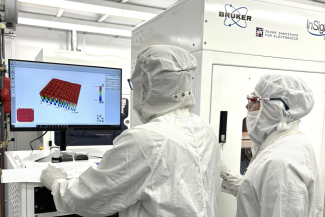
The Texas Institute for Electronics (TIE) at The University of Texas at Austin has been selected to engineer the next generation of high-performing semiconductor microsystems.
Under the $840 million agreement with the U.S. Defense Advanced Research Project Agency (DARPA), TIE will establish a national open-access research and development and prototyping fabrication facility to create higher-performance, lower-power, lightweight and compact semiconductor systems. Such technology could apply to advanced computing, radar, satellite imaging and more.
TIE is a UT Austin-supported semiconductor consortium led in part by Texas Engineers. Using 3D Heterogeneous Integration (3DHI) – a semiconductor fabrication technology that integrates diverse materials and components into microsystems using precision assembly technologies – TIE and UT will enable the design of more powerful and compact microsystems, shaping the future of semiconductors globally.
“By investing in leading-edge microelectronics manufacturing, we are helping secure this vulnerable supply chain, boosting our national security and global competitiveness, and driving innovation in critical technologies,” said U.S. John Sen. Cornyn. “The next generation of high-performing semiconductors these resources will enable through DARPA’s partnership with UT TIE will help not only bolster our defense but also pave the way for the U.S. to reclaim its leadership role in this critical industry, and I look forward to seeing more Texas-led advancements in the years to come.”
UT and TIE have now secured a total of $1.4 billion to engineer the next generation of semiconductors, which power everything from our phones to lifesaving medical equipment. The $840 million award from DARPA is a substantial return on the Texas Legislature’s $552 million investment in TIE, which has funded modernization of two UT fabrication facilities to strengthen long-term U.S. technology leadership. These facilities will be open to industry, academia and government, and will create dual-use innovations supporting the defense sector and the semiconductor industry, including startups, advancing technology for the betterment of society.
“The University of Texas is honored to use our vast talent and expertise in service to our country,” said Kevin Eltife, chairman of the UT System Board of Regents. “This partnership will allow UT Austin faculty, staff and students to bolster our national defense and further demonstrate the University’s global leadership in technology-related teaching and research. We are grateful for the Legislature’s strong support of the Texas Institute for Electronics as it continues to feed the Texas economy and create unrivaled opportunities for Longhorns to change the world.”
DARPA’s Next Generation Microelectronics Manufacturing (NGMM) Program is among the largest federal awards ever to any UT System institution. Moreover, it represents significant progress aligned with UT President Jay Hartzell’s 10-year strategic plan for UT to become the world’s highest-impact public research university. The scope of work will complement UT’s strengths in AI, robotics, circuit design and novel electronics systems development and will draw on the considerable talent of the Cockrell School of Engineering.
“The old Wayne Gretzky quote is ‘Skate to where the puck is going,’ and we worked with the state of Texas to do just that and to compete, and it paid off,” Hartzell said. “We have an opportunity to not only give our military a competitive edge, but this is the kind of major opportunity that creates jobs, attracts businesses, will grow Austin’s innovation ecosystem and cement Texas as a leader in microsystems innovation. I am grateful to DARPA for recognizing our talent and facilities as a worthy investment. I am equally grateful for Professor S.V. Sreenivasan, one of the world’s leading experts in semiconductors, for his vision and leadership and constructing a team that will achieve great things.”
“TIE is tapping into the semiconductor talent available in the Cockrell School of Engineering, in Texas and nationally to build an outstanding team of semiconductor technologists and executives that can create this national center of excellence in 3DHI microsystems,” said S.V. Sreenivasan, TIE founder and chief technology officer and professor in the Cockrell School’s Walker Department of Mechanical Engineering. “This includes the hiring of John Schreck, formerly senior VP at Micron Technology, as CEO. We are also investing in workforce development across Texas to create an enduring talent ecosystem that can support TIE’s future needs.”
The program is composed of two phases — each 2.5 years in length. In Phase 1, TIE will establish the center’s infrastructure and basic capabilities. In Phase 2, the center will engineer 3DHI hardware prototypes important to the Department of Defense and automate processes. It will also work with DARPA on separately funded design challenges.
“DARPA’s vision for the NGMM program includes developing an infrastructure that enables users to efficiently and accurately develop advanced microsystems meeting the defense industry’s stringent quality and reliability standards. This includes design collateral, EDA tools supporting three-dimensional constructs, and emerging capabilities like digital twins,” said John Schreck, CEO of TIE. “With the support of our consortium partners, TIE’s product development infrastructure and services will enable a true open access facility where future microsystems can be developed for a wide range of customers and can be leveraged for other programs well into the future.”
TIE established its strategic vision during the past three years in collaboration with key partners across the semiconductor ecosystem. TIE’s NGMM team is composed of 32 defense electronics and leading commercial semiconductor companies and 18 nationally recognized academic institutions.
The Texas Institute for Electronics is a UT Austin-supported semiconductor consortium of state and local government, preeminent semiconductor and defense electronics companies, national labs and nationally recognized academic institutions with 84,000 square feet of state-of-the-art clean room space. Founded in 2021, TIE’s goal is to create a nationally recognized center for excellence in 3DHI technology, pilot fabrication facilities and semiconductor workforce development.
